Did D6121 and D6122 swap identities in 1964?
Sightings for Locomotives numbered D6121
Sightings for Locomotives numbered D6122
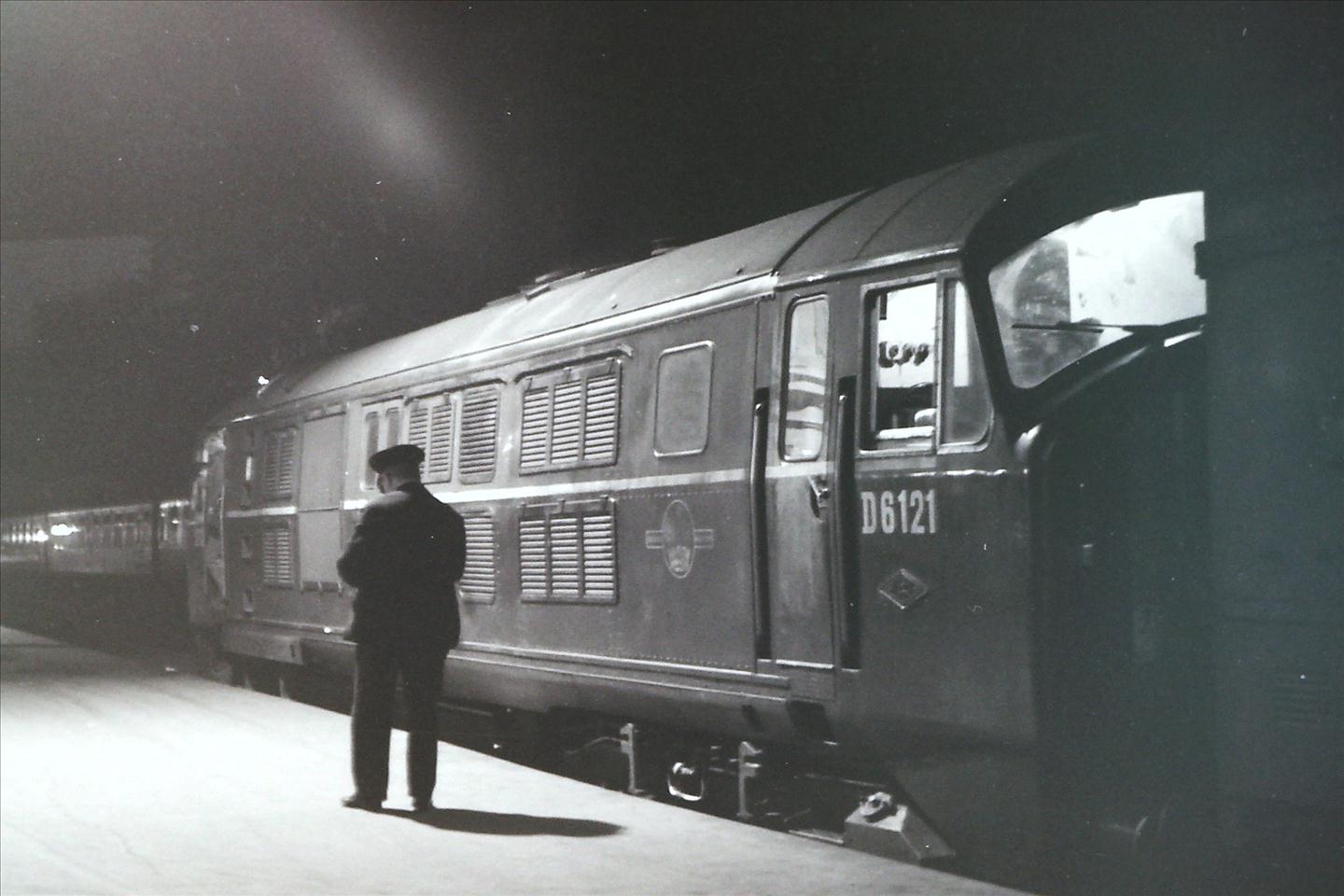
D6121 stands in Edinburgh Waverley on 24th August 1967. By this date it had been re-engined but had it started life as D6122? Ian Cotter
Introduction
For twelve years (1968-1980), Woodham's Barry scrapyard contained a Class 21 locomotive that initially carried numerical identity D6122. As the years went by, weathering revealed that the locomotive may have previously, on the cabs at least, carried numerical identity D6121 at one time. Examination of various photographs does though give further evidence suggesting that this locomotive did indeed start out as D6121 and that it did swap identities with the original D6122 in May 1964. Evidence that an identity swap did take place continues to mount, but as to why remains subject to conjecture. Thus, the intention of this dilemma is to present the current evidence and to appeal for further information. This should be sent to Peter Hall
The progress made so far wouldn't have been possible without the help of Anthony P. Sayer, author of the book 'THE NORTH BRITISH TYPE 2 BO-BO DIESEL ELECTRIC CLASSES 21 & 29' published in 2019. We continue to collaborate closely with Tony on this dilemma and thank him for all his help.
Cab roof 'eyebrow' ventilators
Much like the D6300's, the early D6100's had the cab ventilators, often referred to as 'eyebrows', above the front cab windows. D6100-20 had the 'eyebrows' and D6123-57 didn't, in all photographs of these locomotives viewed so far. This though leaves the intriguing situation with D6121 & D6122 to be explained.
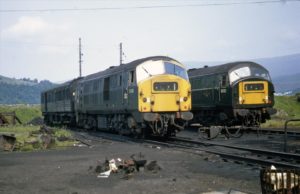
D6121 is pictured at Fort William during 1968 after conversion to a Class 29. It clearly no longer has “eyebrows”. To its left is D6108, also converted to a Class 29, which retains “eyebrows. Both locomotives were built with “eyebrows”. J Richardson
D6121 'eyebrow' ventilators
Confirmation that D6121 definetly had 'eyebrows' when built can be found in the book 'British Railways Main-Line Diesels' by R. S. Carter, first edition published in August 1963. The photograph chosen to depict the NBL diesel electric Type 2s is of D6121 at what looks like Eastfield Depot, taken by D. J. Dipple. The problem is D6121 never appears with eyebrows in any post May 1965 photograph after it had become a Class 29! Unfortunately, no pictures of D6121 taken between May 1964 and June 1965 have ever emerged. Please do make contact if you are aware of any. The accompanying photograph shows D6121 in 1968 without "eyebrows" next to D6108 with "eyebrows".
D6122 'eyebrow' ventilators
Then we move on to D6122. In all the images of this locomotive viewed taken from July 1965 onwards and obviously any Barry shots, it clearly has the 'eyebrows'. Two images of this locomotive in 1960 & 61, clearly showing its number, definitely show it with no 'eyebrows' as does the photograph below taken on 28th March 1962. There is also a picture of D6122 without 'eyebrows' leaving Gleneagles on May 11th 1963 in the book 'Britain's Railways 1948-1998 - a personal view of 50 years of change' (page 72) by Gavin Morrison. The locomotive number being clearly visible. Finally we have the picture below taken on 11th April 1964 at Perth of a damaged D6122 without 'eyebrows'. The earliest picture so far traced showing D6122 with 'eyebrows' was taken on 13th July 1965 at Stirling whilst the earliest published picture was taken on August 28th 1965 from Princess Street Gardens by Brian Stephenson and can be found in 'Trains Illustrated - BR Then & Now, no. 21 The North British Railway' (page 50). The locomotive number is just visible in the Brian Stephenson photograph. Thus, again we unfortunately have no pictures of D6122 taken between May 1964 and June 1965. Please do make contact if you are aware of any.
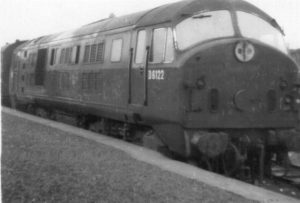
D6122 stands at Holytown prior to departure with the 17.07 to Glasgow Buchanan Street on 28th March 1962. This picture shows that at this time it did not have 'eyebrows' above the cab windows. Peter Smith
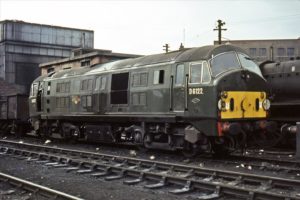
The most recent picture of D6122 without 'eyebrows' so far discovered is this one taken at Perth on 11th April 1964. Interestingly the rear cab appears to have been damaged.
Windscreen wiper mountings
It had been suggested that another clue could be the positioning of windscreen wiper mountings. When delivered the mounting position was above the windscreen. This though was later changed to a position below the windscreen on re-engined locomotives. Pictures of D6121 & D6122 taken up until 1964 show them with windscreen wipers mounted above the windscreen whilst pictures taken from 1965 onwards, after D6121 was re-engined, show D6121 with them mounted below the windscreen and on D6122 still mounted above.
Only re-engined locomotives had the windscreen wiper modification. Below are two photographs kindly provided by Colour-Rail clearly showing the position of the wipers after D6121 had been re-engined.

Colour-Rail
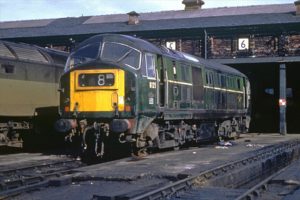
Colour-Rail
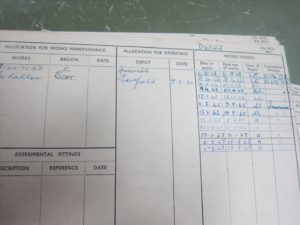
The locomotive record card for D6122 held in the National Archive, Kew, indicates that D6122 spent much of 1963 in St. Rollox Works, Glasgow. Gerard Fletcher
Was D6122 the subject of comparative trials?
A viewer of this dilemma believes that in early 1963, at the same time as D6123 was the first Class 21 converted to a Class 29, D6122 was also overhauled and had its MAN engine uprated. The two locomotives were then used for comparitive trials. The locomotive record card for D6122 held in the National Archive, Kew, a copy of which has been very kindly provided by Gerard Fletcher, does show the locomotive spending a considerable part of 1963 in St. Rollox Works, Glasgow. This is collaborated by D6122 being reported as being uprated from 1,000 to 1,100 h.p. in official changes dated April 1963. Also, J. Brown (Supplies Officer at Inverurie Works in the 1960s) in his book Springburn to Inverurie, specifically mentions D6122: "She had been given a shops overhaul in her original condition to compare her with D6123 which had been fitted with a Paxman Ventura engine".
These trials were presumably thwarted by the collision damaged sustained by D6122 as depicted in the picture above, taken on 11th April 1964. Note that at the time D6122 did not have 'eyebrows'.
It is presumed that in the month following the Perth photograph being taken, D6122 was moved to St. Rollox Works, Glasgow. Any sightings of it during that period could be particularly significant.
Did D6121 & D6122 swap identies in May 1964?
What could well be a vital clue is tucked away on page 236 of the August 1964 RO. There, under a report of the Scottish Whitsun Tour of 16th-18th May 1964 it says with regard to Eastfield Depot "Mention of this depot also brings to mind the confusion caused by D6121 which bore the number D6122 on the cabside at one end. Some cannibalisation has obviously occurred as D6122 is one of the twelve cripples of the class which appear to be more or less permanent residents of St. Rollox Works".
It is presumed from this that a locomotive carrying the number D6122 was seen at St. Rollox Works on the same trip, possibly the same day. Shed Master Archives record D6122 being seen at St. Rollox Works on 17th May. The RCTS comment about D6122 being more or less permanent does though appear strange as it could only have arrived sometime in the previous month.
Although confirmatory sightings are lacking, it does appear that D6121 was moved from Eastfield Depot to St. Rollox Works in August 1963 and remained there until some time in May 1964. Perhaps it was this that was being referred to in the RCTS report.
This potentially puts D6121 & D6122 together in St. Rollox Works in late April / early May 1964, was this when identities were swapped? The locomotive seen at Eastfield Depot on the RCTS trip was D6121 being renumbered D6122 prior to entry back into traffic.
Several enthusiast trips were visiting Glasgow at Whitsun 1964, of those we are aware, it does seem only the RCTS mention D6121 whist D6122 seems to be recorded at both St. Rollox Works and Eastfield Depot by others. This suggests that for a few days at Whitsun 1964 two D6122's existed. The original one in St. Rollox Works and the one at Eastfield depot that was in the process of being renumbered from D6121.
Why an identity swap then? The most plausable explanation has been put forward by Tony. This being that in order to continue the comparitive trials between D6122 and D6123 it was decided to transfer the uprated power unit out of D6122 into another locomotive rather than await the repairing of D6122. The selected locomotive was D6121 and this was done, presumably at St. Rollox Works, but possibly at Eastfield Depot in early May 1964. For whatever reason, it was also decided that the identity of the test locomotive be kept as D6122, thus the identity swap.
Interestingly, the record card gives no indication of D6122 visiting St. Rollox works at the time. Possible explanations for this are that It was done, perhaps, with out formal approval or that it actually took place at Eastfield Depot. Thus the importance of knowing where D6121 and D6122 actually were in the run up to Whitsun 1964.
It is interesting to note that the only report of D6121 in the following year is one of it in what is described as St.Rollox Carriage Shed (between works & shed) with D6101. This suggests that the damaged D6122 was renumbered D6121 soon after Whitsun 1964 and hidden away along with D6101. Anthony has seen the record card for D6121 and there are no mentions of any works visits between early 1963 and July 1965, when it was taken into the re-engining program and converted to a Class 29 at Inverurie works. Sightings received suggest that the locomotive then numbered D6121 was moved from St. Rollox works to Inverurie works around the middle of June 1965 (see below) probably still in damaged condition.
D6121 & D6122 at Inverurie Works in 1965
D6121 Initially seems to have remained hidden in St.Rollox Carriage Shed until moving back to St. Rollox Works were it was reported as being present in the paint shop on 5th June 1965. By 22nd June 1965 it had though reached Inverurie Works were it was transformed into a Class 29.
The 'new' D6122 saw fairly regular use from May 1964 onwards other than occasional visits to Inverurie Works. One of these was between 11th March and 7th May 1965 for collision damage repairs.
What has been the subject of some intrigue are the observations made by Bob Stone at Inverurie Works on 22nd June 1965. Bob records D6121 present as one would expect but also he has recorded "part of D6122". Fifty years on Bob has no recollections but could this be very relevant? Possibly not if what is being refered to is damaged body work that had been replaced on the 'new' D6122 earlier in the year.
D6122 in later years
D6122 was officially condemned at the end of 1967 by which time it had departed from Scotland for Hither Green, and subsequently to Barry. There is some doubt that a report of it being at Perth on 11th September 1967 is correct as other reports and the record card suggest that it was then at Inverurie Works.
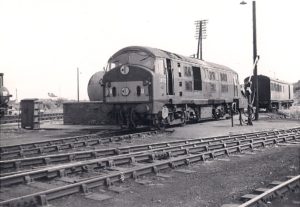
This is the earliest photograph of D6122 with 'eyebrows' that has been made available for publication. It was taken at Stirling on 25th July 1966 Bob Faulkner

The photographer was extremely fortunate to come across D6122 at Crewe South shed on 22nd October 1967. It being en route from Inverurie Works to Hither Green at the time. Clearly, by this time the locomotive had gained eyebrows. Peter Martin
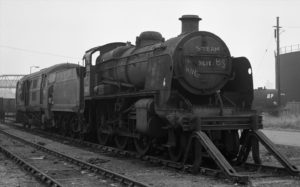
Photographed at Barry Docks on 26th October 1968 was Southern Railway U 31618 and behind it D6122 with eyebrows just visible. Peter Martin
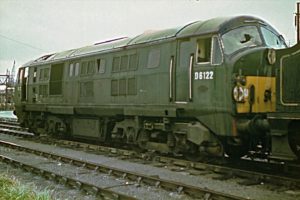
The exact date this picture of D6122 was taken is not known, it shows it coupled to Southern Railway U 31618 at Barry Docks. The eyebrows being clearly visible. Colour Rail
With regard to the above two pictures, Dave Hilling comments. "The colour picture of D6122 was taken at Barry between October and December of 1968. It arrived at Barry with its windows intact, photos of it during October 1968 confirm this. By December the locomotive had not moved, yet all its windows were smashed. There is also, what looks to be a dock crane in the background, confirming Barry". In addition Brian Rolley comments. "The colour picture of D6122 with the smashed windscreen is taken at Barry Docks. The footbridge is, rather was, a landmark. The locos appear to be waiting to be shunted into either Woodhams West Pond main site, or the handful of sidings closer to the former low level goods shed."
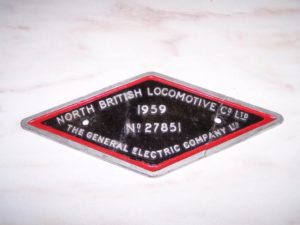
Pictured is the restored builders plate from the locomotive that arrived at Woodham?s Yard numbered D6122. When discovered the plate was in two pieces which accounts for the crack. The smaller piece was still attached to the locomotive whilst the larger piece was found nearby. The number on the plate is recorded as that applied to D6121 in all references consulted.
Builders plate mystery
A notable feature of these locomotives was that when built they carried North British Locomotive Company Builders plates. D6121 is recorded as being number 27851 and D6122 as being number 27852 on their respective plates. It would be thus very interesting to know whether anyone personally checked the builders plates of D6121 and D6122 at any time and can confirm from observation whether this is correct.
Amazingly, it would appear that when first at Barry D6122 did retain its builders plates, or a builders plate. The gentlemen now in possession of one of these has emailed and says the following about it.
"The plate was liberated by myself from Woodham Brothers yard, Barry Docks not long after D6122 (or D6121) arrived there from Hither Green. As it is an alloy plate, it was deemed worthless to the yard! The plate is in two pieces. The larger piece I found in the long grass (literally). The smaller piece of the plate was still attached to the locomotive. I cannot recall which end cab the remains of the plate were affixed to (i.e. the cab that later weathered to show D6121). At the time I liberated the plate both cabs showed D6122. The number on the plate is 27851 which I have since been advised refers to D6121."
So why did the locomotive that arrived at Barry numbered D6122 carry the builders plate from D6121?
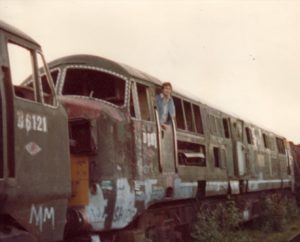
Although this picture of D601 taken on 22nd June 1979 is of D601 the number D6121 rather than D6122 can be clearly seen on the adjacent locomotive, as can the location where the builders plate was mounted. Michael Ponting
Number change mystery
Pictures taken of D6122 soon after arrival at Barry clearly show it as numbered D6122. However, as its twelve year sojourn in the yard progressed weathering revealed that the locomotive may have previously, on the cabs at least, carried numerical identity D6121 at one time. This being further evidence that D6121 was once its identity.
This explains why early visits to the yard record D6122 as being present and those in later years as D6121 being present.
Your observations are welcomed
It would also be very useful to receive any sightings of D6121 & D6122 made in 1963, 1964, 1965, 1966 and 1967 in order to build up as complete picture as possible as to where they were at the time. Those so far received by clicking on the links below or at the top of this page. Please forward your sightings to Peter Hall
Sightings for Locomotives numbered D6121
Sightings for Locomotives numbered D6122
This page is maintained by Peter Hall.
